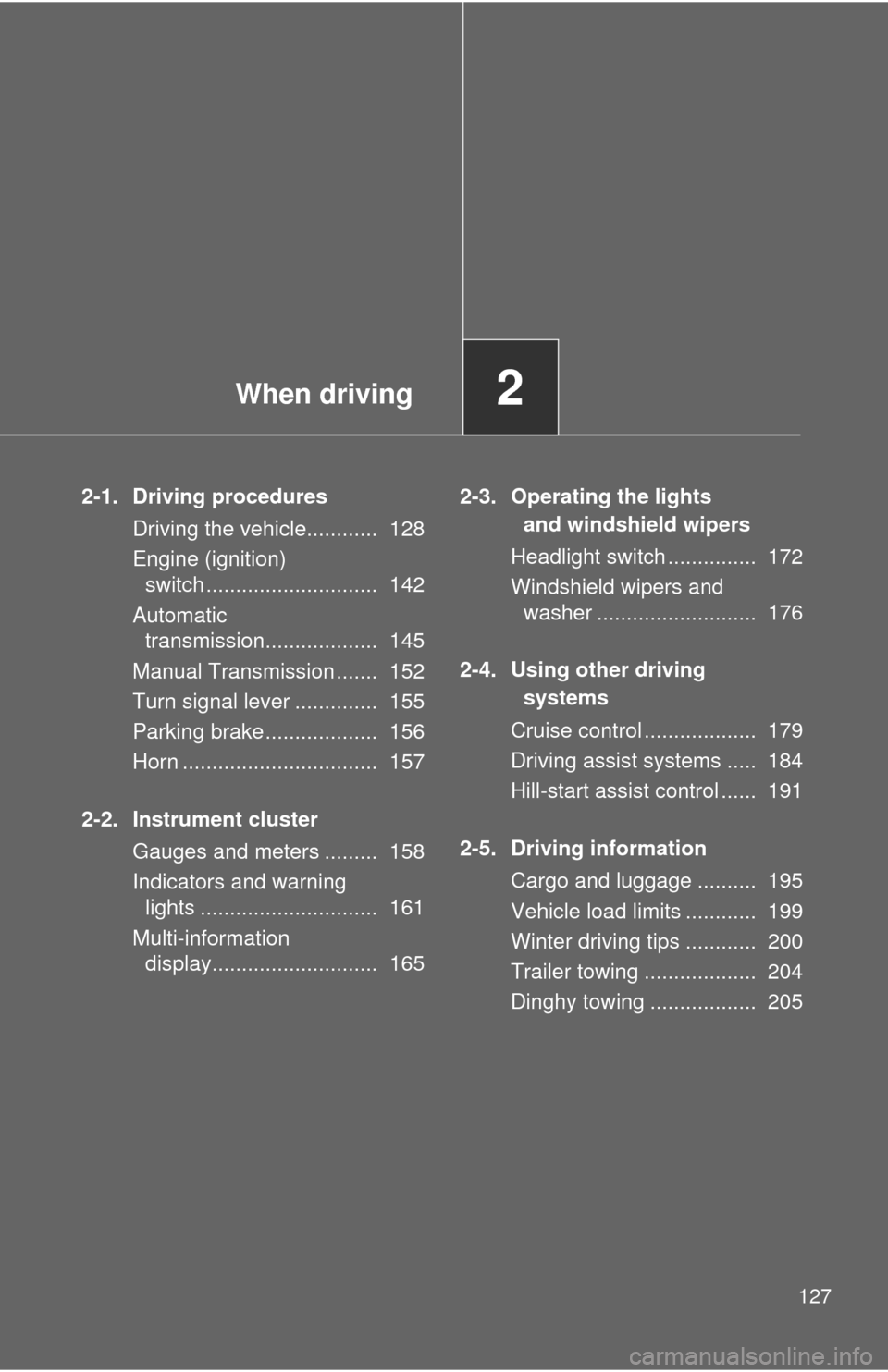Brake TOYOTA GT86 2017 1.G Owners Manual
[x] Cancel search | Manufacturer: TOYOTA, Model Year: 2017, Model line: GT86, Model: TOYOTA GT86 2017 1.GPages: 428, PDF Size: 7.83 MB
Page 2 of 428

TABLE OF CONTENTSIndex
2
1-1. Key informationKeys ..................................... 22
1-2. Opening, closing and locking the doors and
trunk
Wireless remote control ....... 24
Doors.................................... 27
Trunk .................................... 30
1-3. Adjustable components (seats, mirrors,
steering wheel)
Front seats ........................... 35
Rear seats ............................ 38
Head restraints ..................... 40
Seat belts ............................. 42
Steering wheel ..................... 49
Anti-glare inside rear view mirror.......................... 50
Outside rear view mirrors ..... 51
1-4. Opening and closing the windows
Power windows .................... 54
1-5. Refueling Opening the fuel tank cap .... 57
1-6. Theft deterrent system Engine immobilizer system ................................ 61
Theft prevention labels (U.S.A.) .............................. 63 1-7. Safety information
Correct driving posture ......... 64
SRS airbag (Supplemental Restraint
System airbag) ................... 66
Front passenger occupant classification system ......... 104
Child restraint systems ....... 112
Installing child restraints ..... 116
2-1. Driving procedures Driving the vehicle .............. 128
Engine (ignition) switch....... 142
Automatic transmission ...... 145
Manual Transmission ......... 152
Turn signal lever ................. 155
Parking brake ..................... 156
Horn .................................... 157
2-2. Instrument cluster Gauges and meters ............ 158
Indicators and warning lights ................................. 161
Multi-information display ..... 165
2-3. Operating the lights and windshield wipers
Headlight switch ................. 172
Windshield wipers and washer .............................. 176
1Before driving
2When driving
Page 10 of 428

10
∗: If equipped
C
Shift lever P. 145, 152
Parking brake lever P. 156
VSC/TRAC off switch P. 185
“TRACK” switch P. 186
Power outlet P. 230
Shift lock override button ∗ P. 339
Driving pattern selector switch ∗ P. 147
Pictorial indexInterior
Page 16 of 428

16
Installation of a mobile two-way radio system
The installation of a mobile two-way radio system in your vehicle could affect
electronic systems such as:
● Multiport fuel injection system/sequential multiport fuel injection system
● Cruise control system
● Anti-lock brake system
● SRS airbag system
● Seat belt pretensioner system
Be sure to check with your Toyota dealer for precautionary measures or spe-
cial instructions regarding installation of a mobile two-way radio system.
Page 17 of 428

17
Vehicle data recordings
Your Toyota is equipped with several sophisticated computers that will record
certain data, such as:
• Accelerator status
• Brake status
• Vehicle speed
The recorded data varies according to the vehicle grade level and options
with which it is equipped. These computers do not record conversations or
sounds, and only record images outside of the vehicle in certain situations.
● Data Transmission
Your vehicle may transmit the data recorded in these computers to Toyota
without notification to you.
● Data usage
Toyota may use the data recorded in these computers to diagnose malfunc-
tions, conduct research and development, and improve quality.
Toyota will not disclose the recorded data to a third party except:
• With the consent of the vehicle owner or with the consent of the lessee if the vehicle is leased
• In response to an official request by the police, a court of law or a govern-
ment agency
• For use by Toyota in a lawsuit
• For research purposes where the data is not tied to a specific vehicle or
vehicle owner
● To learn more about the vehicle data collected, used and shared by
Toyota, please visit www.toyota.com/privacyvts/
.
Page 18 of 428

18
Event data recorder
This vehicle is equipped with an event data recorder (EDR). The main pur-
pose of an EDR is to record, in certain crash or near crash-like situations,
such as an air bag deployment or hitting a road obstacle, data that will assist
in understanding how a vehicle’s systems performed. The EDR is designed
to record data related to vehicle dynamics and safety systems for a short
period of time, typically 30 seconds or less.
The EDR in this vehicle is designed to record such data as:
• How various systems in your vehicle were operating;
• Whether or not the driver and passenger safety belts were buckled/fas-tened;
• How far (if at all) the driver was depressing the accelerator and/or brake pedal; and,
• How fast the vehicle was traveling.
These data can help provide a better understanding of the circumstances in
which crashes and injuries occur.
NOTE: EDR data are recorded by your vehicle only if a non-trivial crash situ-
ation occurs; no data are recorded by the EDR under normal driving condi-
tions and no personal data (e.g., name, gender, age, and crash location) are
recorded. However, other parties, such as law enforcement, could combine
the EDR data with the type of personally identifying data routinely acquired
during a crash investigation.
To read data recorded by an EDR, special equipment is required, and access
to the vehicle or the EDR is needed. In addition to the vehicle manufacturer,
other parties, such as law enforcement, that have the special equipment, can
read the information if they have access to the vehicle or the EDR.
● Disclosure of the EDR data
Toyota will not disclose the data recorded in an EDR to a third party except
when:
• An agreement from the vehicle’s owner (or the lessee for a leased vehicle) is obtained
• In response to an official request by the police, a court of law or a govern- ment agency
• For use by Toyota in a law suit
However, if necessary, Toyota may:
• Use the data for research on vehicle safety performance
• Disclose the data to a third party for research purposes without disclosing
information about the specific vehicle or vehicle owner
Page 39 of 428

39
1-3. Adjustable components (s
eats, mirrors, steering wheel)
1
Before driving
WARNING
■When folding the rear seatbacks down
Observe the following precautions. Failure to do so may result in death or
serious injury.
●Do not fold the seatbacks down while driving.
● Stop the vehicle on level ground, set the parking brake and shift the shift
lever to P (automatic transmission) or N (manual transmission).
● Do not allow anyone to sit on a folded seatback or in the trunk while driv-
ing.
● Do not allow children to enter the trunk.
■ After returning the rear seatback to the upright position
Observe the following precautions. Failure to do so may result in death or
serious injury.
●Check that the seat belts are not twisted or caught in the seatback.
■ Before using the rear seat belts
●Make sure that the seatback is securely
locked in position by lightly pushing it
back and forth.
If the seatback is not securely locked,
the red portion of the seatback lock
indicator will be visible. Make sure that
the red portion is not visible.
Always make sure that the seat belt is not
caught in the seatback or twisted in one
of the hooks that secure the seatback.
Failure to do so may cause the seat belt
to not be fastened correctly or to become
ineffective in a collision, resulting in death
or serious injury.
Page 127 of 428

When driving2
127
2-1. Driving proceduresDriving the vehicle............ 128
Engine (ignition) switch ............................. 142
Automatic transmission................... 145
Manual Transmission ....... 152
Turn signal lever .............. 155
Parking brake ................... 156
Horn ................................. 157
2-2. Instrument cluster Gauges and meters ......... 158
Indicators and warning lights .............................. 161
Multi-information display............................ 165 2-3. Operating the lights
and windshield wipers
Headlight switch ............... 172
Windshield wipers and washer ........................... 176
2-4. Using other driving systems
Cruise control ................... 179
Driving assist systems ..... 184
Hill-start assist control ...... 191
2-5. Driving information Cargo and luggage .......... 195
Vehicle load limits ............ 199
Winter driving tips ............ 200
Trailer towing ................... 204
Dinghy towing .................. 205
Page 128 of 428

128
2-1. Driving procedures
Driving the vehicle
The following procedures should be observed to ensure safe driv-
ing:
■ Starting the engine
→P. 142
■ Driving
Vehicles with an au tomatic transmission
With the brake pedal depressed, shift the shift lever to D.
( → P. 145)
Release the parking brake. ( →P. 156)
Gradually release the brake pedal and gently depress the
accelerator pedal to accelerate the vehicle.
Vehicles with a manual transmission While depressing the clutch pedal , shift the shift lever to 1.
( → P. 152)
Release the parking brake. ( →P. 156)
Gradually release the clutch pedal. At the same time, gently
depress the accelerator pedal to accelerate the vehicle.
■ Stopping
Vehicles with an au tomatic transmission
With the shift lever in D, depress the brake pedal.
If necessary, set the parking brake.
If the vehicle is to be stopped for an extended period of time, shift
the shift lever to P or N. ( →P. 145)
Vehicles with a manual transmission
While depressing the clutch pedal, depress the brake
pedal.
If necessary, set the parking brake.
If the vehicle is to be stopped for an extended period of time, shift
the shift lever to N. (
→P. 152)
STEP 1
STEP 2
STEP 3
STEP 1
STEP 2
STEP 3
STEP 1
STEP 2
STEP 1
STEP 2
Page 129 of 428

129
2-1. Driving procedures
2
When driving
■
Parking the vehicle
Vehicles with an au tomatic transmission
With the shift lever in D, depress the brake pedal.
Shift the shift lever to P. ( →P. 145)
Set the parking brake. ( →P. 156)
Turn the engine switch to the “LOCK” position to stop the
engine.
Lock the door, making sure that you have the key on your
person.
If parking on a hill, block the wheels as needed.
Vehicles with a manual transmission While depressing the clutch pedal, depress the brake
pedal.
Shift the shift lever to N. ( →P. 152)
Set the parking brake. ( →P. 156)
Turn the engine switch to the “LOCK” position to stop the
engine.
Lock the door, making sure that you have the key on your
person.
If parking on a hill, shift the shift lever to 1 or R and block the
wheels as needed.
STEP 1
STEP 2
STEP 3
STEP 4
STEP 5
STEP 1
STEP 2
STEP 3
STEP 4
STEP 5
Page 130 of 428

130 2-1. Driving procedures
Starting off on a steep uphillVehicles with an au tomatic transmission
Make sure that the parking brake is set and shift the shift lever
to D.
Gently depress the accelerator pedal.
Release the parking brake.
Vehicles with a manual transmission With the parking brake firmly set and the clutch pedal fully
depressed, shift the shift lever to 1.
Lightly depress the accelerator pedal at the same time as
gradually releasing the clutch pedal.
Release the parking brake.
■ When starting off on an uphill
When enabled, the hill-start assist control can operate. ( →P. 191)
■ Driving in the rain
●Drive carefully when it is raining, because visibility will be reduced, the
windows may become fogged-up, and the road will be slippery.
● Drive carefully when it starts to rain, because the road surface will be
especially slippery.
● Refrain from high speeds when driving on an expressway in the rain,
because there may be a layer of water between the tires and the road
surface, preventing the steering and brakes from operating properly.
STEP 1
STEP 2
STEP 3
STEP 1
STEP 2
STEP 3